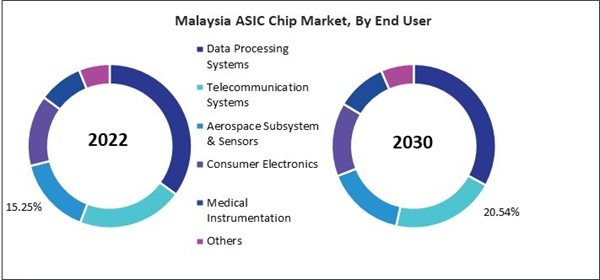The China market dominated the Asia Pacific ASIC Chip Market by Country in 2022, and would continue to be a dominant market till 2030; thereby, achieving a market value of $3,623.4 million by 2030. The Japan market is experiencing a CAGR of 7.8% during (2023 - 2030). Additionally, The India market would exhibit a CAGR of 9.2% during (2023 - 2030).
In the ever-changing field of semiconductor technology, application-specific integrated circuits (ASICs) have become a crucial component for driving various electronic devices and systems. As the need for tailored and efficient solutions rises across different industries, the market has experienced notable expansion and development. The versatility of ASICs extends across a broad spectrum of application domains, each harnessing the specialized capabilities of these chips to address unique challenges. One of the prominent areas of application is the telecommunications industry, where ASICs power critical components such as base stations, routers, and network switches. The demand for high-speed data processing and efficient packet switching in the era of 5G networks propels the integration of ASICs into the heart of telecommunications infrastructure.
Moreover, ASICs play a pivotal role in the automotive sector, contributing to developing advanced driver assistance systems (ADAS), autonomous vehicles, and in-vehicle entertainment systems. Their ability to handle complex algorithms with low latency aligns perfectly with real-time processing requirements in automotive applications. ASICs are instrumental in powering the sophisticated features of ADAS. These systems encompass a range of safety and convenience functions, including adaptive cruise control, lane departure warning, collision avoidance, and automated emergency braking. ASICs, with their tailored design, enable efficient processing of the algorithms involved in real-time sensor data analysis, allowing vehicles to respond quickly to changing road conditions.
In addition, India has witnessed significant growth in its telecom network, especially with the proliferation of mobile devices and the increasing demand for high-speed data services. This expansion has led to a growing need for specialized ASICs in various network elements, such as base stations, routers, and switches. As per the data released in 2023 from Invest India, the telecom industry is one of the most important sectors in the Indian economy, with a 6.5% contribution to the country’s GDP. In the last quarter of FY 2022-2023, the industry’s gross revenue was INR 85,356 Cr ($11.38 Bn). Hence, the expanding telecom and medical device sectors in the Asia Pacific will assist in the growth of the regional market.
Based on Type, the market is segmented into Semi- custom ASIC, Full custom ASIC, and Programmable ASIC. Based on End User, the market is segmented into Data Processing Systems, Telecommunication Systems, Aerospace Subsystem & Sensors, Consumer Electronics, Medical Instrumentation, and Others. Based on countries, the market is segmented into China, Japan, India, South Korea, Taiwan, Malaysia, and Rest of Asia Pacific.
List of Key Companies Profiled
- Advanced Micro Devices, Inc.
- Samsung Electronics Co., Ltd. (Samsung Group)
- ON Semiconductor Corporation
- Taiwan Semiconductor Manufacturing Company Limited
- NVIDIA Corporation
- Intel Corporation
- Infineon Technologies AG
- Texas Instruments, Inc.
- Seiko Epson Corporation
- BITMAIN Technologies Holding Company
Market Report Segmentation
By Type- Semi- custom ASIC
- Full custom ASIC
- Programmable ASIC
- Data Processing Systems
- Telecommunication Systems
- Aerospace Subsystem & Sensors
- Consumer Electronics
- Medical Instrumentation
- Others
- China
- Japan
- India
- South Korea
- Singapore
- Malaysia
- Rest of Asia Pacific
Table of Contents
Companies Mentioned
- Advanced Micro Devices, Inc.
- Samsung Electronics Co., Ltd. (Samsung Group)
- ON Semiconductor Corporation
- Taiwan Semiconductor Manufacturing Company Limited
- NVIDIA Corporation
- Intel Corporation
- Infineon Technologies AG
- Texas Instruments, Inc.
- Seiko Epson Corporation
- BITMAIN Technologies Holding Company
Methodology

LOADING...









